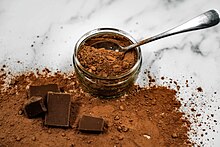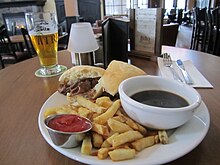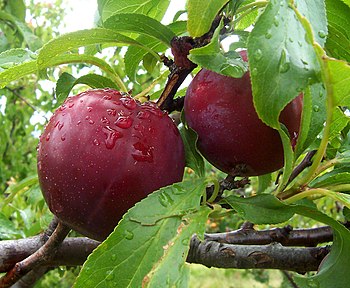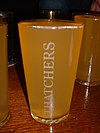F o o d
A portal dedicated to food and foodways
Introduction


Food is any substance consumed by an organism for nutritional support. Food is usually of plant, animal, or fungal origin and contains essential nutrients such as carbohydrates, fats, proteins, vitamins, or minerals. The substance is ingested by an organism and assimilated by the organism's cells to provide energy, maintain life, or stimulate growth. Different species of animals have different feeding behaviours that satisfy the needs of their metabolisms and have evolved to fill a specific ecological niche within specific geographical contexts.
Omnivorous humans are highly adaptable and have adapted to obtain food in many different ecosystems. Humans generally use cooking to prepare food for consumption. The majority of the food energy required is supplied by the industrial food industry, which produces food through intensive agriculture and distributes it through complex food processing and food distribution systems. This system of conventional agriculture relies heavily on fossil fuels, which means that the food and agricultural systems are one of the major contributors to climate change, accounting for as much as 37% of total greenhouse gas emissions. (Full article...)
Cooking, also known as cookery or professionally as the culinary arts, is the art, science and craft of using heat to make food more palatable, digestible, nutritious, or safe. Cooking techniques and ingredients vary widely, from grilling food over an open fire, to using electric stoves, to baking in various types of ovens, reflecting local conditions.
Preparing food with heat or fire is an activity unique to humans. Archeological evidence of cooking fires from at least 300,000 years ago exists, but some estimate that humans started cooking up to 2 million years ago.
The expansion of agriculture, commerce, trade, and transportation between civilizations in different regions offered cooks many new ingredients. New inventions and technologies, such as the invention of pottery for holding and boiling of water, expanded cooking techniques. Some modern cooks apply advanced scientific techniques to food preparation to further enhance the flavor of the dish served. (Full article...)
Miran Pastourma is a renowned pastourma and sujuk charcuterie business and market in Athens, Greece. The market has been in operation since 1922. It is considered the charcuterie of the connoisseurs. Despite the Greek economic crisis, Miran is expanding its business and has doubled in size to accommodate increased demand. The founder of the shop, Miran Kourounlian, is thought to be the man who brought pastourma to Athens for the first time. Miran is considered the largest company of its kind in the European Union. The flavour of pastourma coming from the historical enterprise permeates Euripides Street in the centre of Athens. Miran and its neighbor Arapian Cold Cuts are considered two of the historical establishments of Athens. Miran has been in the same spot in Euripidou Street since its opening in 1922. Miran is the recipient of multiple gourmet prizes. (Full article...)
Selected article –

Bread has a significance beyond mere nutrition in many cultures in the Western world and Asia because of its history and contemporary importance. Bread is also significant in Christianity as one of the elements (alongside wine) of the Eucharist; see sacramental bread. The word companion comes from Latin com- "with" + panis "bread".
The political significance of bread is considerable. In 19th century Britain, the inflated price of bread due to the Corn Laws caused major political and social divisions, and was central to debates over free trade versus protectionism. The Assize of Bread and Ale in the 13th century demonstrated the importance of bread in medieval times by setting heavy punishments for short-changing bakers, and bread appeared in Magna Carta a half-century earlier. (Full article...)Selected cuisine -
The cuisine of New Zealand is largely driven by local ingredients and seasonal variations. As an island nation with a primarily agricultural economy, New Zealand yields produce from land and sea. Similar to the cuisine of Australia, the cuisine of New Zealand is a diverse British-based cuisine, with Mediterranean and Pacific Rim influences as the country has become more cosmopolitan.
Historical influences came from British cuisine and Māori culture. Since the 1970s, new cuisines such as New American cuisine, Southeast Asian, East Asian, and South Asian have become popular. (Full article...)Selected ingredient –
Chocolate or cocoa is a food made from roasted and ground cacao seed kernels that is available as a liquid, solid, or paste, either on its own or as a flavoring agent in other foods. Cacao has been consumed in some form for at least 5,300 years starting with the Mayo-Chinchipe culture in what is present-day Ecuador. Later Mesoamerican civilizations also consumed chocolate beverages before being introduced to Europe in the 16th century.
The seeds of the cacao tree have an intense bitter taste and must be fermented to develop the flavor. After fermentation, the seeds are dried, cleaned, and roasted. The shell is removed to produce cocoa nibs, which are then ground to cocoa mass, unadulterated chocolate in rough form. Once the cocoa mass is liquefied by heating, it is called chocolate liquor. The liquor may also be cooled and processed into its two components: cocoa solids and cocoa butter. Baking chocolate, also called bitter chocolate, contains cocoa solids and cocoa butter in varying proportions without any added sugar. Powdered baking cocoa, which contains more fiber than cocoa butter, can be processed with alkali to produce Dutch cocoa. Much of the chocolate consumed today is in the form of sweet chocolate, a combination of cocoa solids, cocoa butter, or added vegetable oils and sugar. Milk chocolate is sweet chocolate that additionally contains milk powder or condensed milk. White chocolate contains cocoa butter, sugar, and milk, but no cocoa solids. (Full article...)
Selected recipe –
A French dip sandwich, also known as a beef dip, is a hot sandwich consisting of thinly sliced roast beef (or, sometimes, other meats) on a "French roll" or baguette. It is usually served plain but a popular variation is to top with Swiss cheese, onions, and a dipping container of beef broth produced from the cooking process (termed au jus, "with juice"). Beef stock, a light beef gravy, or beef consommé is sometimes substituted. The sandwich is an American invention, with the name seeming to refer to the style of bread, rather than any French origin. Although the sandwich is most commonly served with a cup of jus or broth on the side of the plate, into which the sandwich is dipped as it is eaten, this is not how the sandwich was served when it was originally developed. (Full article...)
Thomcord is a seedless table grape variety and a hybrid of the popular Thompson Seedless or Sultanina grape (a Vitis vinifera variety) and Concord grape (a Vitis labrusca variety). Thomcord was developed in 1983 by Californian grape breeders working for the Agricultural Research Service (ARS), an agency of the United States Department of Agriculture (USDA), as part of a test to better understand a new seedless grape breeding procedure.
Its aromatic, "labrusca" flavor is similar to that of Concord, but mellowed by the mild, sweet taste from Thompson Seedless. Thomcord grows well in hot, dry climates, ripens between late July and mid-August, and tolerates powdery mildew. It is a productive variety, yielding an average of 15.1 kg (33 lb) of grapes per vine, but has produced as much as 30 to 32 kg (66 to 71 lb) per vine in grower trials. The berries weigh between 2.72 and 3.38 g (0.096 and 0.119 oz) and have a medium-thick, blue-black skin that adheres to the fruit, unlike Concord, which has a thick skin that can slip off the pulp easily. The aborted seeds in the fruit body are relatively small, but larger than those in Thompson Seedless. (Full article...)Selected image –
Selected biography –
B. September 13, 1857 – d. October 13, 1945
Milton Snavely Hershey (September 13, 1857 – October 13, 1945) was an American chocolatier, businessman, and philanthropist.
Trained in the confectionery business, Hershey pioneered the manufacture of caramel, using fresh milk. He launched the Lancaster Caramel Company, which achieved bulk exports, and then sold it to start a new company supplying mass-produced milk chocolate, previously a luxury good. (Full article...)
Did you know (auto-generated) –

- ... that the vegan-food brand Squeaky Bean produces food that does not contain beans?
- ... that the reactions to food depicted in the manga series Food Wars!: Shokugeki no Soma were decided on through free association games?
- ... that food critic Grace Dent reviewed a Liverpool restaurant that served her rice pudding flavoured with a substance that is banned in the United States for its lethality?
- ... that British architect Diane Haigh transformed one historic building into an art gallery and another into a hospice?
- ... that in Spain, it is considered lucky to eat twelve grapes while wearing red underwear received as a gift at midnight on New Year's Eve?
- ... that a British supermarket uses barriers to prevent shoppers grabbing food with yellow discount stickers out of the hands of staff?
More did you know –
Related portals
Food topics
The following are topics relating to food
Categories
Food list articles
- See also: Lists of foods and Category:Lists of drinks
The following are some Food list articles on Wikipedia:

- American cheeses
- Appellation d'Origine Contrôlée cheeses
- Apple cultivars
- Bacon dishes
- Bacon substitutes
- Basil cultivars
- Breads
- Breakfast beverages
- Breakfast cereals
- Breakfast foods
- British cheeses
- Cakes
- Candies
- Cheeses
- Cheese soups
- Christmas dishes (list)
- Cocktails
- Cookies
- Dishes using coconut milk
- Diets
- Doughnut varieties
- Egg dishes
- Fermented soy products
- Food additives
- Food additives (Codex Alimentarius)
- Foods named after people
- French cheeses
- French dishes
- Fried dough foods
- Fruits
- List of hamburgers
- Herbs and spices
- Hors d'oeuvre
- Indian dishes
- Indian snack foods
- Indonesian dishes
- Italian dishes
- Japanese snacks
- Japanese dishes
- Jewish dishes
- Kebabs
- Korean beverages
- Mango cultivars
- Moroccan dishes
- Pasta
- Pastries
- Philippine snack food
- Pies, tarts and flans
- Poppy seed pastries and dishes
- Potato dishes
- Puddings
- Raw fish dishes
- Rice dishes
- Rolled foods
- Sauces
- Seafood
- Seeds
- Sandwiches
- Snack foods
- Soft drinks by country
- Soul foods and dishes
- Soups
- Stews
- Street foods
- Tapas
- Turkish dishes
- Twice-baked foods
- Vegetable oils
- Vegetables
- Vodkas
Things you can do
Related WikiProjects
| Parent project: WikiProject Food and Drink | |
| Child projects: | Task forces: (All inactive) |
|
|
| Related projects: | |
New articles
Rules | Match log | Results page (for watching) | Last updated: 2024-04-30 19:18 (UTC)
Note: The list display can now be customized by each user. See List display personalization for details.
- Koffi (restaurant) ( | talk | history | links | watch | logs | tools) by Another Believer (talk · contribs · new pages (158)) started on 2024-04-30, score: 10
- H. Avard Loomer ( | talk | history | links | watch | logs | tools) by B3251 (talk · contribs · new pages (29)) started on 2024-04-30, score: 10
- Sherman's Deli & Bakery ( | talk | history | links | watch | logs | tools) by Another Believer (talk · contribs · new pages (158)) started on 2024-04-30, score: 10
- Paul B. Wishart ( | talk | history | links | watch | logs | tools) by Dmarsch (talk · contribs · new pages (5)) started on 2024-04-29, score: 10
- Meat water holding capacity ( | talk | history | links | watch | logs | tools) by GobsPint (talk · contribs · new pages (140)) started on 2024-04-29, score: 10
- Meat diaper ( | talk | history | links | watch | logs | tools) by GobsPint (talk · contribs · new pages (140)) started on 2024-04-29, score: 20
- Localis (restaurant) ( | talk | history | links | watch | logs | tools) by Another Believer (talk · contribs · new pages (158)) started on 2024-04-29, score: 10
- Waxi's ( | talk | history | links | watch | logs | tools) by Jacobo Marcus Galicia (talk · contribs · new pages (1)) started on 2024-04-25, score: 10
- Westman's Bagel & Coffee ( | talk | history | links | watch | logs | tools) by Another Believer (talk · contribs · new pages (158)) started on 2024-04-19, score: 10
- Kōki Saitō ( | talk | history | links | watch | logs | tools) by Cynikles (talk · contribs · new pages (1)) started on 2024-04-29, score: 10
- 24 in 24: Last Chef Standing ( | talk | history | links | watch | logs | tools) by TristanQuinn (talk · contribs · new pages (2)) started on 2024-04-29, score: 10
- La Mejor Bakery ( | talk | history | links | watch | logs | tools) by BaduFerreira (talk · contribs · new pages (10)) started on 2024-04-29, score: 20
- Wilson Davis ( | talk | history | links | watch | logs | tools) by Vycl1994 (talk · contribs · new pages (18)) started on 2024-04-28, score: 10
- Sweet Rose Creamery ( | talk | history | links | watch | logs | tools) by TrademarkedTWOrantula (talk · contribs · new pages (5)) started on 2024-04-28, score: 10
- Hunters Palm Springs ( | talk | history | links | watch | logs | tools) by Another Believer (talk · contribs · new pages (158)) started on 2024-04-28, score: 10
- Haitian spaghetti ( | talk | history | links | watch | logs | tools) by Valereee (talk · contribs · new pages (8)) started on 2024-04-27, score: 10
- Artocarpus styracifolius ( | talk | history | links | watch | logs | tools) by Ulathijau (talk · contribs · new pages (2)) started on 2024-04-27, score: 10
- Atomo ( | talk | history | links | watch | logs | tools) by White 720 (talk · contribs · new pages (2)) started on 2024-04-27, score: 30
- Lauren Rudolph E. coli case ( | talk | history | links | watch | logs | tools) by Margaretdonnelly (talk · contribs · new pages (1)) started on 2024-04-23, score: 10
- Ruditapes philippinarum ( | talk | history | links | watch | logs | tools) by Sjl197 (talk · contribs · new pages (1)) started on 2024-04-27, score: 10
- Bonèt ( | talk | history | links | watch | logs | tools) by Frankserafini87 (talk · contribs · new pages (3)) started on 2024-04-26, score: 20
- Ganmianpi ( | talk | history | links | watch | logs | tools) by Iuliusnanus (talk · contribs · new pages (8)) started on 2024-04-25, score: 10
- D'Ambrosio Gelato ( | talk | history | links | watch | logs | tools) by Another Believer (talk · contribs · new pages (158)) started on 2024-04-25, score: 10
- Murcian meat pie ( | talk | history | links | watch | logs | tools) by ChampClancy (talk · contribs · new pages (1)) started on 2024-04-24, score: 20
- Full Tilt Ice Cream ( | talk | history | links | watch | logs | tools) by Another Believer (talk · contribs · new pages (158)) started on 2024-04-24, score: 10
- Roger Hugo ( | talk | history | links | watch | logs | tools) by NouveauSarfas (talk · contribs · new pages (1)) started on 2024-04-24, score: 10
- Gelatiamo ( | talk | history | links | watch | logs | tools) by Another Believer (talk · contribs · new pages (158)) started on 2024-04-24, score: 10
- Paratrophis banksii ( | talk | history | links | watch | logs | tools) by Tom Radulovich (talk · contribs · new pages (155)) started on 2024-04-23, score: 10
- Dumb bread ( | talk | history | links | watch | logs | tools) by LittleT889 (talk · contribs · new pages (12)) started on 2024-04-23, score: 10
- Frankie & Jo's ( | talk | history | links | watch | logs | tools) by Another Believer (talk · contribs · new pages (158)) started on 2024-04-23, score: 10
- List of food and drink monuments ( | talk | history | links | watch | logs | tools) by Altenmann (talk · contribs · new pages (77)) started on 2024-04-23, score: 20
- Ko Omm ( | talk | history | links | watch | logs | tools) by Sattwaikyaw (talk · contribs · new pages (1)) started on 2024-04-22, score: 10
- Nourishing Hope ( | talk | history | links | watch | logs | tools) by Raearutherford (talk · contribs · new pages (1)) started on 2024-04-16, score: 10
- Rachel's Ginger Beer ( | talk | history | links | watch | logs | tools) by Another Believer (talk · contribs · new pages (158)) started on 2024-04-22, score: 10
- Crisp pork ( | talk | history | links | watch | logs | tools) by チャリス (talk · contribs · new pages (8)) started on 2024-04-22, score: 20
- "Flower" tofu ( | talk | history | links | watch | logs | tools) by チャリス (talk · contribs · new pages (8)) started on 2024-04-22, score: 10
- Taro pastry ( | talk | history | links | watch | logs | tools) by Heeheemalu (talk · contribs · new pages (14)) started on 2024-04-22, score: 10
- Garbage Plate ( | talk | history | links | watch | logs | tools) by BanjoZebra (talk · contribs · new pages (5)) started on 2024-04-10, score: 40
- Morning in America (EP) ( | talk | history | links | watch | logs | tools) by OttoJohn (talk · contribs · new pages (1)) started on 2024-04-21, score: 10
- Mike's Hot Honey ( | talk | history | links | watch | logs | tools) by BanjoZebra (talk · contribs · new pages (5)) started on 2024-04-21, score: 40
- Zajiangmian ( | talk | history | links | watch | logs | tools) by チャリス (talk · contribs · new pages (8)) started on 2024-04-21, score: 20
- Cannabis in the restaurant industry ( | talk | history | links | watch | logs | tools) by Another Believer (talk · contribs · new pages (158)) started on 2024-04-21, score: 10
- Kentrell Barkley ( | talk | history | links | watch | logs | tools) by Skyggestadium (talk · contribs · new pages (7)) started on 2024-04-21, score: 10
- Coffee Talk Episode 2: Hibiscus & Butterfly ( | talk | history | links | watch | logs | tools) by JuniperChill (talk · contribs · new pages (12)) started on 2024-04-20, score: 20
- Dough Joy ( | talk | history | links | watch | logs | tools) by Another Believer (talk · contribs · new pages (158)) started on 2024-04-20, score: 20
- Chicken galantina ( | talk | history | links | watch | logs | tools) by Obsidian Soul (talk · contribs · new pages (36)) started on 2024-04-19, score: 20
- Ponche Navideño ( | talk | history | links | watch | logs | tools) by Valereee (talk · contribs · new pages (8)) started on 2024-04-19, score: 20
- Lengua estofado ( | talk | history | links | watch | logs | tools) by Obsidian Soul (talk · contribs · new pages (36)) started on 2024-04-19, score: 20
- PDX671 ( | talk | history | links | watch | logs | tools) by Another Believer (talk · contribs · new pages (158)) started on 2024-04-19, score: 10
- Organic market in Ukraine ( | talk | history | links | watch | logs | tools) by QFTP2024 (talk · contribs · new pages (1)) started on 2024-04-16, score: 10
- Taqua banana ( | talk | history | links | watch | logs | tools) by Fredo.fernando (talk · contribs · new pages (1)) started on 2024-04-18, score: 10
- Butifarra (sandwich) ( | talk | history | links | watch | logs | tools) by Tony24644 (talk · contribs · new pages (6)) started on 2024-04-18, score: 10
- Kuai Kuai ( | talk | history | links | watch | logs | tools) by Heeheemalu (talk · contribs · new pages (14)) started on 2024-04-17, score: 20
- Rocklands Barbeque and Grilling Company ( | talk | history | links | watch | logs | tools) by DarkNight0917 (talk · contribs · new pages (7)) started on 2024-04-17, score: 10
- Sweet Alchemy ( | talk | history | links | watch | logs | tools) by Another Believer (talk · contribs · new pages (158)) started on 2024-04-16, score: 10
- Diet Coke ( | talk | history | links | watch | logs | tools) by 99.196.135.213 (talk · contribs · new pages (1)) started on 2024-04-16, score: 20
- The Lakes Distillery ( | talk | history | links | watch | logs | tools) by ChefBear01 (talk · contribs · new pages (5)) started on 2024-04-16, score: 20
- Cully & Sully ( | talk | history | links | watch | logs | tools) by Liz (talk · contribs · new pages (88)) started on 2024-04-16, score: 30
- Trine Lotherington Danielsen ( | talk | history | links | watch | logs | tools) by Geschichte (talk · contribs · new pages (24)) started on 2024-04-16, score: 10
- Medical Device User Fee and Modernization Act ( | talk | history | links | watch | logs | tools) by GobsPint (talk · contribs · new pages (140)) started on 2024-04-16, score: 10
- Uneeda Biscuit ( | talk | history | links | watch | logs | tools) by CNMall41 (talk · contribs · new pages (21)) started on 2024-04-10, score: 30
Associated Wikimedia
The following Wikimedia Foundation sister projects provide more on this subject:
-
 Commons
Commons
Free media repository -
 Wikibooks
Wikibooks
Free textbooks and manuals -
 Wikidata
Wikidata
Free knowledge base -
 Wikinews
Wikinews
Free-content news -
 Wikiquote
Wikiquote
Collection of quotations -
 Wikisource
Wikisource
Free-content library -
 Wikiversity
Wikiversity
Free learning tools -
 Wiktionary
Wiktionary
Dictionary and thesaurus












































